- Geopolitics
- Non State Actors
- Organised crime
- Intelligence School


Special Frontier Force: Tibetan Elite Mountain Warfare Unit
Tibet under pressure: a 12-month outlook, molecular assassins: the history and impact of bio-weapons, poland defence sector: a surge in investments and procurement, bayraktar tb-2: turkey’s rise to drone superpower, togo in turmoil: constitutional reform or coup de force, big safari: the us air force’s marriage with private acquisition.
1.0 Introduction:
In the world of military aviation, innovation and adaptability are essential to maintaining an edge over potential adversaries. The United States Air Force (USAF) has consistently pushed the boundaries of technology, and one program that has played a pivotal role in achieving this is the Big Safari program.
Founded in 1952, Big Safari has been at the forefront of the rapid acquisition and modification of aircraft, enabling the US Air Force to respond quickly to emerging threats and operational requirements. The purpose of Big Safari was to marry talent and technology from private industry with the US Air Force’s evolving portfolio of requirements during the Cold War.
Big Safari was very much a product of the contest between East and West. It gave birth to aircraft which are fascinating in their own right and have become household names. In this article, we will explore the success, development and controversies surrounding Big Safari.
2.0 Mottos, Symbols and Patches:
The following is a cursory overview of the mottos, symbols and patches associated with Big Safari. There are two variations of patches associated with Big Safari, one blue and one tan. The tan one is illustrated below.
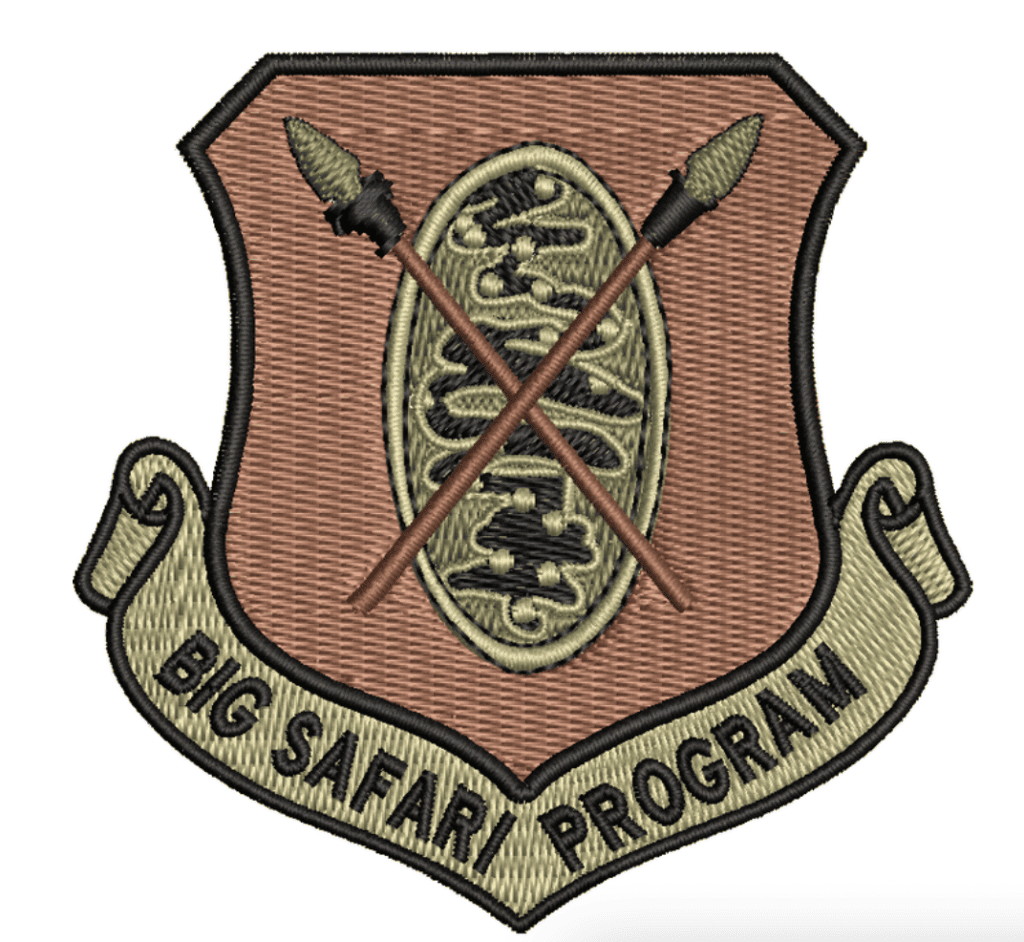
There is no official motto printed on the Big Safari patch. Overall, there is no official motto associated with Big Safari. After the program was reactivated in 2006 as the 645th Aeronautical Systems Group, the US Air Force still did not award the program a motto. The emblem was officially approved by the Pentagon in 2021 [ source ]. On top of this, there is no official explanation of the symbolism of the patch.
3.0 History:
In 1952, the United States found itself in an increasingly crowded threat environment. Although the fight against fascism led the United States into a brief partnership with the Soviet Union, the spirit of amicability dissipated rapidly. Soon, the USSR imposed an Iron Curtain across the breadth of Europe and the Korean Peninsula turned into a shooting gallery. The nucleus of what eventually became Big Safari began with USAF Brig. General Walter Wise [source]. General Lauris Norstad, then the commander of US Air Forces in Europe, found himself in need of an aircraft which didn’t exist. In order to peer across the Iron Curtain, General Norstad needed a totally new reconnaissance aircraft capable of performing intelligence-gathering capabilities. In order to quickly develop this new aircraft, Air Force Chief of Staff Hoyt Vandenberg convened a series of meetings with high-level Air Force officers to develop a system which would allow the Air Force to procure the needed systems to rapidly give birth to special projects. To quote one of the Air Force generals involved in the inception of the Big Safari program, George Rhodes:
“There wasn’t anything common with what we were doing. We sat down and said OK: if we are going to do this, the first thing we have to do is to have procurement procedures that permit us to designate the contractor”.
The need to quickly procure contractors for special projects was at the heart of Big Safari’s purpose from the very beginning. The effort was initially envisioned as a 5-year program [source]. Rhodes established 8 separate guidelines which would govern the procurement of contracts and acquisition of new technology. Two of these guidelines stand out above the others. The first was that was not to be any set limit to budgets. The second was that every special project would be closed off to general personnel of the USAF [ source ]. In early 1952, responsibility for carrying out these tasks fell to the Air Material Command, under which Big Safari was initially organized.
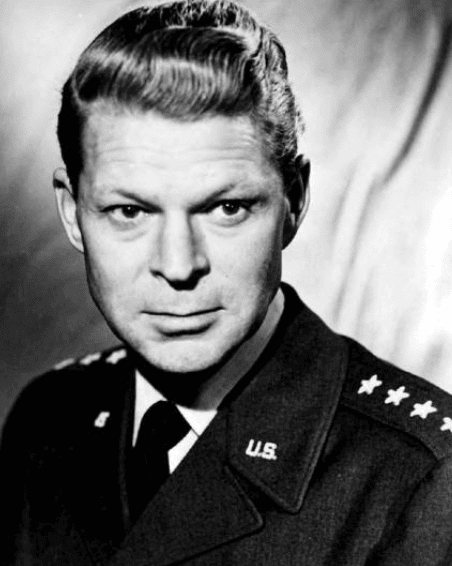
3.1 Later History and Reorganization:
The program was reorganized in 2004 and officially activated as a part of the 645th Aeronautical Systems Group in 2006 [ source ]. During its history, Big Safari went on to create the Rivet Joint program of reconnaissance aircraft and support ELINT, MASINT, IMINT and GEOINT intelligence collection efforts throughout the Cold War [source]. A major early contracting partner with the Big Safari program was Convair. Per Rhodes’ guidelines, all development took place at the Convair plant in Fort Worth from 1952 to 1961 [source]. Throughout the duration of these efforts, US Air Force personnel were absent from production efforts. Big Safari is probably the best example of private industry and military necessity for this reason. The Pentagon appears to have fully delegated the task of developing mission-critical aircraft. In this sense, it could very well be described as the origin of what President Eisenhower contemporaneously called the military-industrial complex.
4.0 Organization:
The Big Safari program was initially placed under the direction of the Air Material Command. The AMC was a major command of the newly formed USAF which handles the procurement, logistics and technical requirements of USAF aircraft. During the Kennedy Administration, the Department of Defense underwent a reorganization through a process similar to the Base Realignment and Closure (BRAC) system [ source ]. The AMC was split into the Air Force Logistics Command and the Air Force Systems Command. Big Safari worked closely onwards with Systems Command [ source ].
In 1992, these 2 commands were once again recombined into the AMC. Big Safari was eventually reactivated in 2005 after a hiatus of unknown length, though it is likely that the program was inactive from the late 1970s till the late 1980s [source]. It was in 2005 that Big Safari explicitly became the 645th Aeronautical Systems Group. The 645th is subordinated under the 303rd Aeronautical Systems Wing. Reportedly, the National Air and Space Intelligence Center provides a certain degree of input into the decision-making process at Big Safari [ source ].
5.0 Notable Aircraft:
There are literally hundreds of aircraft which were developed by Big Safari or received some degree of input from the program. They are too numerous to list in exhaustive form here. Rather, we will focus on a select number illustrating the program’s driving mantra. The program almost exclusively focused on reconnaissance and surveillance aircraft.
5.1 PIE FACE:
PIE FACE was the very first aircraft which fell under the Big Safari umbrella. The Air Force initially partnered with General Dynamics – Convair in order to streamline the procurement of aircraft for special ISR missions, and PIE FACE was the first dry run of this effort. What General Norstad realized in early 1951 was that the USAF’s ISR platforms were not well equipped to image East German and Soviet military formations and equipment moving into Berlin. While we do not know the specific limitations of the Air Force’s previous imaging equipment, given the nature of what was developed in PIE FACE, we can surmise that image resolution was far too poor for the purpose. The Air Force tasked an engineering team at Harvard University to develop a monster of a camera.
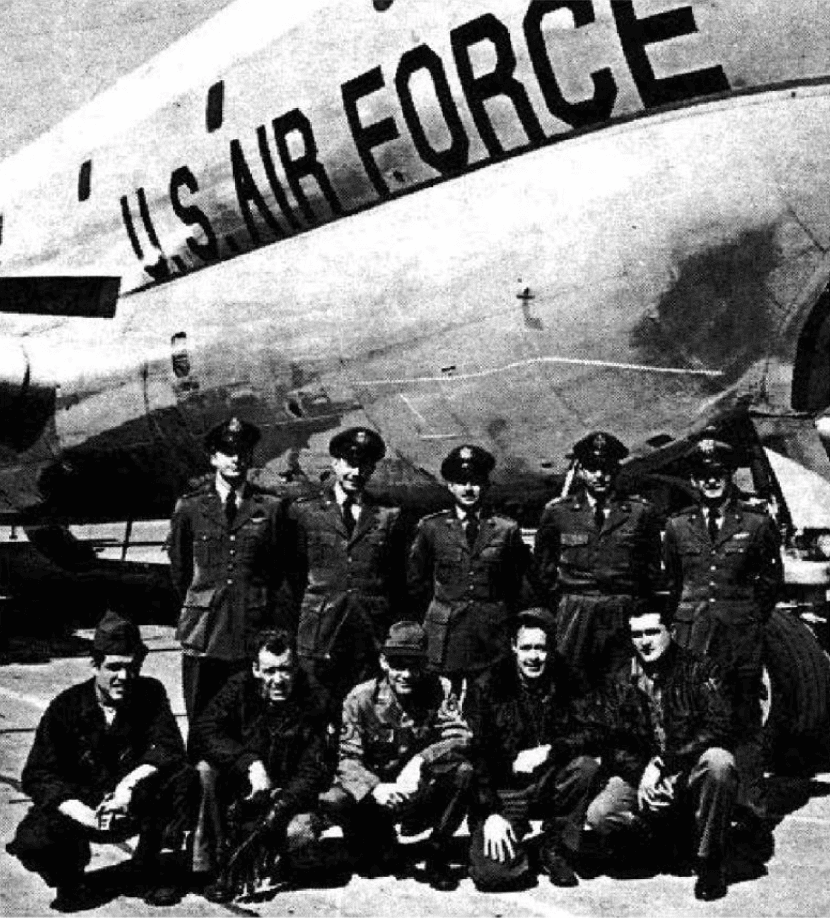
The team at Harvard developed a 20-foot-long camera lens, equipped with a pair of reflective mirrors and a huge F-8 lens. At the time, this was the largest camera installed in an aircraft [ source ]. A camera of that size would need a comparable airframe. The 2 units, known as Bertha and Betsy Mae, would come to use the largest roll of film ever ordered from Kodiak in the entire history of that company [ source ]. The only aircraft which was suitable at the time to host this immense array of optical equipment was the KC-97A. The aircraft was upgraded with structural modifications that could support the enormity of the camera. The PIE FACE aircraft was also equipped with 3 K-17 optical instruments [ source ]. PIE FACE went on to fly multiple ISR missions along the Berlin Air Corridor.
5.1 SARA JANE :
In 1954, Soviet premier Khrushchev visited the United States in an effort to thaw growing tensions and East-West rivalry [ source ]. American intelligence officials were reportedly convinced that Khrushchev’s Tu-114 was being used to photograph American military installations as it flew in [ source ]. Even if it was or was not true, it gave birth to the concept of SARA JANE. The idea was to convert C-54E VIP transport aircraft into ISR platforms that could fly over enemy installations in plain sight and under the guise of a diplomatic mission.
The entire project was obscured in an extra level of secrecy at Convair’s facility in Texas [ source ]. In total, 14 P2 cameras were fastened into the wings of the aircraft in fuel-tight pockets. These P2 cameras were complimented by a suite of additional lenses manufactured by Fairchild. Rather ingeniously, engineers added a mechanism that would dump fuel if the panels covering the cameras were removed. The design was designed to be totally covert, so much so that if if anyone ran an X-Ray over the wing, the mechanism would be hidden. The pilot was able to trigger pneumatic doors which covered the lenses from the cockpit, allowing the flight crew to activate the ISR suite at their discretion [ source ].
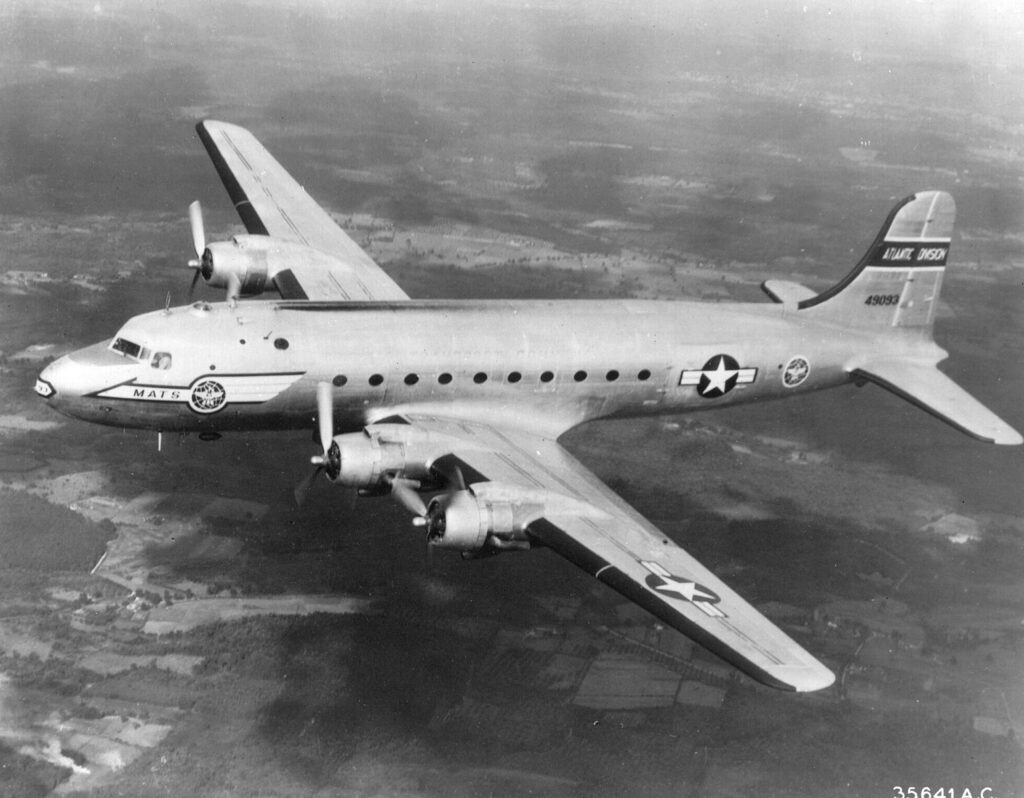
The two SARA JANE aircraft were stationed across West Germany and were probably utilized as Embassy support aircraft. One aircraft was used to fly supplies to the US Embassy in Moscow. According to retired USAF Colonel Dan Gareri, a Soviet officer accompanied the crew on this flight. By use of a covert inter-phone panel installed in the crew cabin, US personnel were able to secretly trigger the ISR suite without the knowledge of the Soviet minder [ source ].
5.2 NANCY RAE :
Beginning in the early 1960’s the need for large, heavy strategic bombers to deliver nuclear payloads over Soviet or American cities was beginning to wane. This was due in part to the addition of two new arms of the nuclear triad, submarine-launched ballistic missiles (SLBMs) and intercontinental ballistic missiles (ICBMs). Commensurate with that shift, however, was the growing need to monitor Soviet ICBM tests with highly advanced sensors aboard intelligence aircraft. NANCY RAE was an early attempt to fill this intelligence gap. The aircraft initially was an unmodified KC-135 which underwent extensive upgrades at the Big Safari facility in Texas [ source ].
The sensors aboard NANCY RAE can be broadly classified into 2 different varieties, optical sensors and ELINT sensors. These sensors would measure not only the trajectory and irradiance of the ICBM’s reentry but also ground communication from Soviet naval assets or ground forces. According to one crew member on NANCY RAE, the crew practically lived on the aircraft while it was deployed in Dakar, Senegal [ source ]. Col. Bill Grimes, a major figure in the Big Safari saga, was deployed on NANCY RAE during it’s later flights.
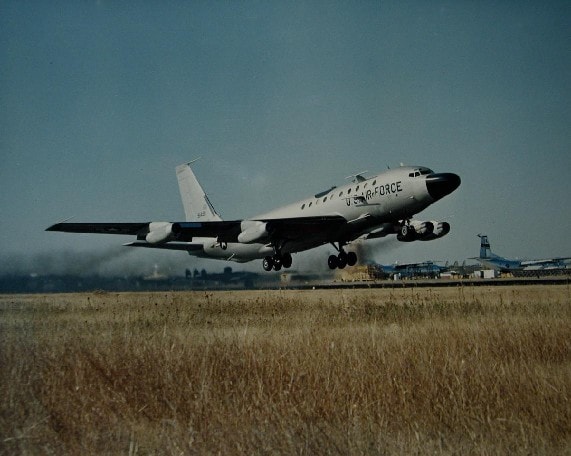
NANCY RAE had a prolific career. It’s 40-strong crew gained the title “Ali Baba and the 40 Thieves”. This name reflected the uncanny ability of NANCY RAE to grab sensitive Soviet communications. The aircraft’s mission profile was so successful that President Kennedy was given weekly briefings on the data gathered by the aircraft [ source ].
5.3 SPEED LIGHT BRAVO:
SPEED LIGHT BRAVO provides an excellent glimpse into exactly why the Big Safari program existed in the first place. On 9 August 1964, Soviet Premier Nikita Khrushchev issued an alarming proclamation. He asserted that the USSR was fully capable of building and detonating a 100-megaton nuclear bomb. This was a shocking amount of destructive firepower. In order to prove his claim, he announced that the USSR would conduct a test of a warhead at a 50-megaton yield. Reportedly, this announcement caught the immediate attention of researchers at the Los Alamos Laboratory in New Mexico [ source ].
The team at Los Alamos had a sensor array capable of monitoring the gigantic explosion, but no suitable aircraft to carry it close to the detonation site. A request was put in with Fort Worth and Big Safari to load this sensor array onto a JKC-135A. This particular aircraft had been outfitted with lead lining in limited areas, making it suitable to monitor the single largest explosion in human history [ source ].
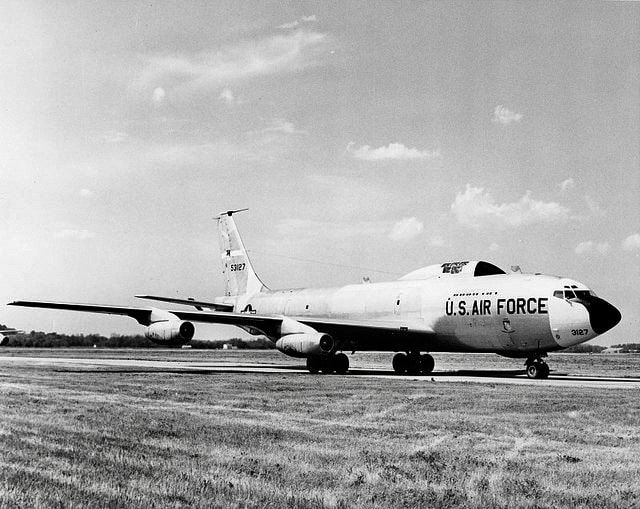
Between 22 and 27 October, 1964, SPEED LIGHT BRAVO was received and outfitted with the relevant sensors, a mere 5 days [ source ]. This is probably the best example which highlights the purpose of the Big Safari program. A team of researchers identified a need. The military stepped into the connect their technology with a private contractor, in this case Convair, and the contractor delivered a finished product in less than a week. Reportedly, the Air Force was told to push the project through and deal with the paper work later [ source ].
On 30 October, a Soviet Tu-95 bomber dropped a nuclear payload over Sukhoy Nos on Severny Island. This payload was dubbed BIG IVAN, but it is better known as the Tsar Bomba. The device was intentionally blunted so that it would only detonate at 50 megatons. The detonation was so massive that the nuclear blast created a shockwave the repelled against the earth, such that the fireball never actually reached the ground [ source ]. SPEED LIGHT BRAVO was damaged by the sheer heat of the event and totally irradiated, although the crew appeared to be unaffected by the extreme radiation [ source ]. Nevertheless, the aircraft was eventually scrapped after it was deemed un-airworthy. SPEED LIGHT BRAVO unintentionally flew far to close to the blast zone [ source ].


5.4 PEE WEE 1-3:
The PEE WEE program stands out amongst other Big Safari endeavors due to the close cooperation of the Pakistani Air Force in it’s implementation. Originally a set of B-57 Canberra bombers, these aircraft played a vital role in surveillance of Soviet missile launches out of Kaputsin Yar. The US Navy had a poor track record of honoring commitments made to Pakistan and India, repeatedly crossing over into restricted airspaces of either country. Accordingly, Islamabad told the US Navy it was no longer welcome in Peshawar [ source ].
After a series of discussions with the Pakistani’s, the United States ultimately came into a comprised arrangement. Pakistan would allow for the resumption of intelligence gathering air operations with aircraft piloted by Pakistani officers. Moreover, the Pakistani’s would be responsible for the upkeep of the aircraft [ source ]. The bomb bay of the aircraft was fitted out with a sensor capable of receiving missile telemetry and the nose cone was elongated to accommodate a dual set of phased array S-band antennae [ source ]. Sensors were installed for radiation detection [ source ]. PEE WEE I and PEE WEE II were operational for little more than a year until the introduction of PEE WEE III.
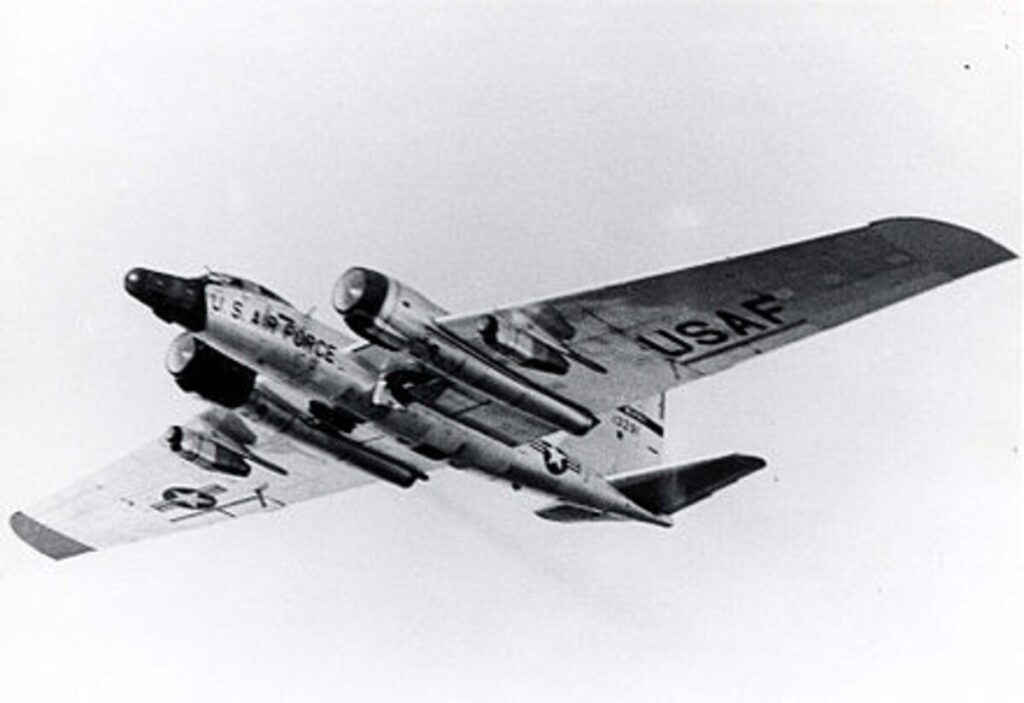
When the USSR shot down Gary Powers and his U-2 spy plane in 1960, President Eisenhower instituted a moratorium on high-altitude reconnaissance flights over the Soviet Union. PEE WEE III attempted to reinstate that mission profile. PEE WEE III was a complete redesign of the B-57’s airframe. The wingspan was doubled to an impressive 121 feet. Two additional engines were added, a set of Pratt and Whitney TF-33-P-11 Turbofan engines. These were far more powerful than the previous Wright J-65 Turbojets. To complement this increased power, two Pratt and Whitney air-started J60-P-9 turbojets were mounted under each wing and could be detached from the cockpit [source]. In addition to this, the cockpit was modified to fit two crew members wearing purpose-built pressurized suits to sustain the crew at high altitudes. A newer ejection seat system was also installed. Because of the high importance that this program entailed, Big Safari was given free rein to avoid cumbersome regulations and bureaucratic fancies to finish the aircraft on time [ source ].
Alongside Soviet missile tests, it is probable that PEE WEE aircraft were used to collect intelligence on Chinese nuclear activities as well. At least one PEE WEE III aircraft was significantly damaged during the 1965 Indo-Pakistani War [ source ].
5.5 RIVET DIGGER:
With the introduction of the Limited Test Ban Treaty in August of 1963, the global environment was given a respite from the deleterious effects of atmospheric nuclear testing. However, Cold War paranoias meant that the United States never fully trusted the Soviet Union to adhere to the terms of the treaty. The ‘Readiness Program’ was started in order to rapidly re-activate nuclear test monitoring aircraft if the Soviet Union decided to violate the terms of the treaty. The EARLY DAY/RIVET DIGGER aircraft were the answer to that need.
Three NC-135A aircraft were set aside for the project. Each was ‘sponsored’ by a different scientific organization. Overall, the KC-135 family of aircraft has undergone numerous modifications and adaptations to fulfil a wide range of specialized roles [source]. These variants have showcased the platform’s flexibility and longevity, allowing it to remain a vital asset in military operations, aerial refuelling, intelligence gathering, and experimental research. RIVET DIGGER probably stands out amongst all of the other variants due to its bizarre features. The aircraft was crewed by personnel from the Air Force Special Weapons Center but complemented by a scientific contingent from each of the sponsoring scientific bodies. Evidently, military personnel found it difficult to manage the larger-than-life egos of the science teams from Lawrence Livermore, Los Alamos and Sandia National Laboratories [ source ].
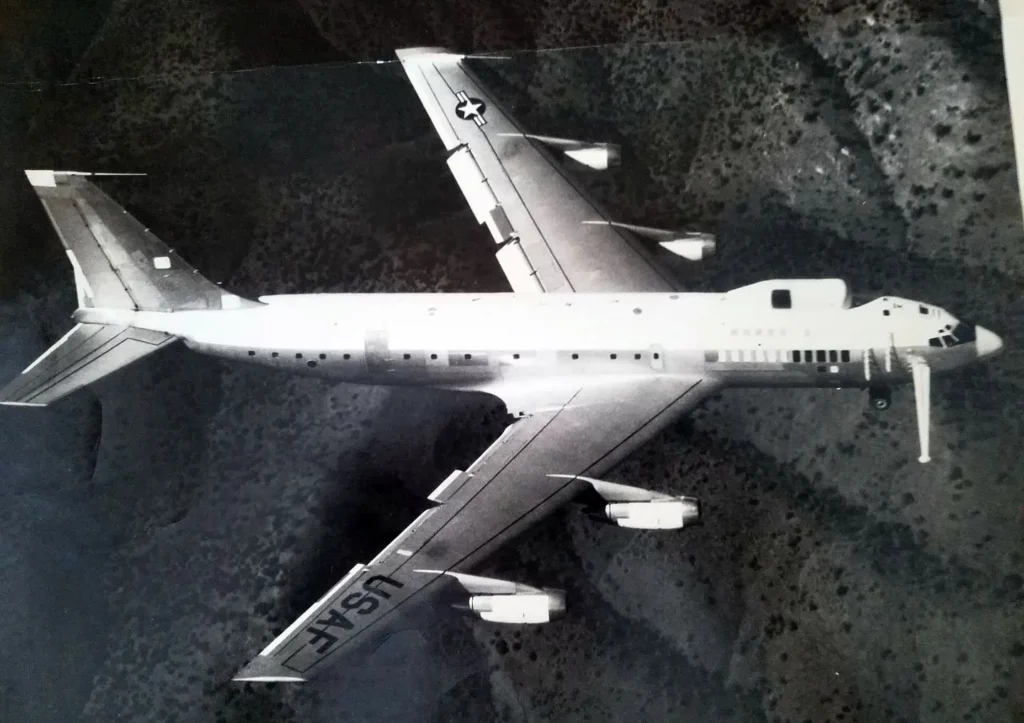
These aircraft were designed to conduct intelligence gathering on atmospheric nuclear tests, but when they were not used in that capacity, they were deployed for scientific data collection flights. These induced studying solar eclipses and cosmic rays [ source ].
6.0 Phoenix Ghost UAV
This April, the White House officially announced the existence of a new UAV during an announcement of a new aid package to the Ukrainian military. Among the various items, the US was sending 120 Phoenix Ghost suicide drones. Likely very similar to the Switchblade UAV, the Phoenix Ghost is reported to have a certain degree of ISR capabilities. The entire project was managed and sourced through Big Safari [ source ].
The Ukrainians have already begun intensive training with the platform and it’s possible that the system has already been deployed in the Donbas [ source ]. It is still too early to truly assess the impact of this new UAS, but the public will almost certainly be able to catch even a cursory glimpse of its performance in Ukraine given the shower of information and media which is posted online regularly.
7.0 Big Safari and L3 Harris:
Big Safari initially started out with a special relationship with General Dynamics – Convair. Over time, relationships have shifted. Currently, one of Big Safari’s major partners is L3 Harris. This relationship has not been without a degree of turbulence. The Inspector General of the Department of Defense has investigated L3 over the transfer of ISR platforms to the Kenyan government [ source ].
In 2017, L3 and Big Safari came under intense scrutiny from two GOP members of the House of Representatives. According to two USAF Majors, L3 was awarded a contract for the sale of aircraft to Yemen at an excess of $15 million more than the next competitor, IOMAX in 2014 [ source ]. In the case of the Pentagon’s Inspector General’s investigation, it was alleged that L3 was awarded a contract to manufacture border security aircraft for the Kenyan government despite having little to no experience in actually designing or manufacturing aircraft to the required specifications [ source ].
8.0 Other Controversies:
While the US Air Force’s Big Safari program has been lauded for its contributions to the rapid acquisition and modification of aircraft, there have been some controversies associated with the program. These controversies mainly revolve around issues such as cost overruns, lack of transparency, and concerns about accountability. Here are some of the controversies surrounding Big Safari:
Budgetary Concerns: One of the primary controversies surrounding Big Safari is the issue of cost overruns. Critics argue that the program has experienced significant budgetary challenges, with projects exceeding initial estimates and timelines. This has led to increased scrutiny of the program’s financial management and calls for improved cost-control measures. For example, a contract went to L3 over IOMAX, $15 million above IOMAX’s stated price [ source ].
Lack of Transparency: Some critics have raised concerns about the lack of transparency surrounding the Big Safari program. As it operates in a classified environment, there is limited public visibility into the program’s activities, decision-making processes, and project outcomes. This lack of transparency has led to questions about accountability and the potential for misuse of resources [ source ].
Contracting Practices: The contracting practices associated with Big Safari have also faced scrutiny. Critics argue that the program relies heavily on sole-source contracts, limiting competition and potentially resulting in higher costs. There have been calls for greater competition and increased oversight to ensure fairness and efficiency in the acquisition process [ source ].
Impact on Traditional Acquisition Programs: Another controversy arises from the perception that Big Safari’s rapid acquisition and modification capabilities may divert resources and attention from traditional acquisition programs. Some argue that the focus on quick solutions through Big Safari may hinder the development of long-term, sustainable systems and technologies [ source ].
Ethical Considerations: The nature of Big Safari’s operations, often involving sensitive technologies and classified information, raises ethical considerations. Critics question the program’s adherence to legal and ethical standards in areas such as privacy, data collection, and potential implications for international norms, agreements and the laws of war [ source ], [ source ].
Congressional Oversight: Controversies surrounding Big Safari have prompted increased congressional oversight. Lawmakers have called for more rigorous monitoring, accountability, and reporting on the program’s activities to ensure proper use of taxpayer funds and alignment with national defence priorities [ source ].
It is important to note that the controversies surrounding Big Safari should be viewed in the context of the program’s mission and the challenging nature of rapidly acquiring and modifying aircraft in a dynamic operational environment.
9.0 Conclusion:
The history of the US Air Force’s Big Safari program is one of continuous innovation, adaptation, and collaboration. From its early focus on electronic reconnaissance to its involvement in developing stealth aircraft and supporting special operations, Big Safari has consistently pushed the boundaries of airborne capabilities. By bridging the gap between traditional acquisition processes and operational needs, the program has played a pivotal role in ensuring the US Air Force remains at the forefront of airborne innovation and rapid acquisition capabilities. Very recently, the US Space Force announced the establishment of the ‘Space Safari’ program through the Space and Missile Systems Center Special Programs Directorate. Space Safari will play the exact same role as Big Safari for USSPACECOM [ source ].
These partnerships demonstrate the importance of collaboration between the US Air Force and industry leaders in driving innovation, leveraging expertise, and delivering cutting-edge capabilities for the Big Safari program. By combining the resources and knowledge of these partners, the USAF can rapidly respond to emerging operational requirements and maintain a technological edge in the ever-evolving landscape of military aviation.

Table of contents
Get the weekly email from Grey Dynamics that makes reading intel articles and reports actually enjoyable. Join our mailing list to stay in the loop for free!
Related contents
Grey Dynamics is an Intelligence firm based out of London with a network of analysts, researchers, and investigators worldwide.
- Privacy Policy
- Terms & Conditions
- USAF's Big Safari Program receives TC-135W, prepares to divest last NC-135W

On February 14, a USAF -operated Boeing TC-135W (serial 62-4133) departed Offutt Air Force Base (AFB) , Nebraska, for Greenville-Majors Airport, Texas, where it will be reassigned to the air arm’s Big Safari Program and redesignated as an NC-135 platform.
The aircraft was flown to Texas by members of the 238th Combat Training Squadron under the callsign ‘Windsor 01’ and will ultimately become responsible for the testing of surveillance equipment modifications which, if successful, will be added to the USAF’s core fleet of RC-135S/U/V/W reconnaissance aircraft. This is not the first time that 62-4133 has been operated in the test role since it completed its maiden flight in July 1962. In 1967, the aircraft was redesignated as an EC-135B when it received a 10ft nose extension and was fitted with equipment from the EC-135N Apollo Range Instrument Aircraft (ARIA).

It was then converted into a TC-135S in 1985 and served as a training aircraft for the RC-135S Cobra Ball fleet. At the time, these aircraft did not have the ‘chipmunk cheeks’ fitted to the forward fuselage that is a synonymous feature of the RC-135 fleet today. Until now, the aircraft had served as part of the 45th Reconnaissance Squadron in this same role.
Having been delivered for its new assignment, 62-4133 will now take over the Big Safari test role from NC-135W (serial 61-2666), which has been responsible for testing equipment for the core RC-135 fleet since the mid-1990s. This aircraft – which is the sole remaining C-135 in the USAF inventory that is equipped with Pratt & Whitney TF-33 turbofan engines – will be retired from use once 62-4133 becomes fully available.
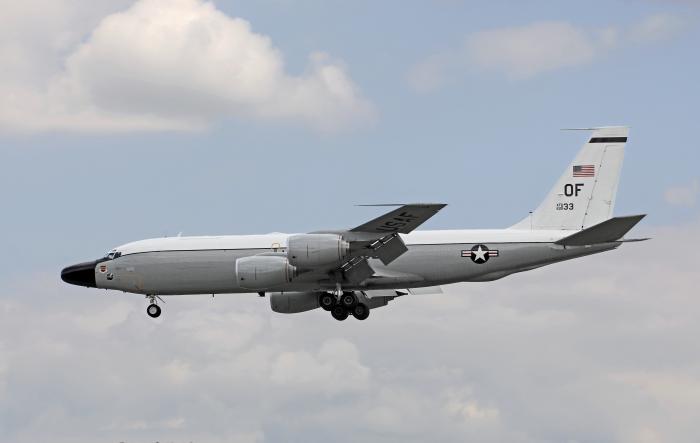
Its retirement follows a series of divestments of a similar nature, including the two OC-135B Open Skies aircraft and the WC-135C/W Constant Phoenix fleet, which was used for atmospheric testing and collection purposes. As these aircraft have aged, parts have become less available and the airframes have grown more difficult to maintain. The introduction of 62-4133 as the new NC-135 test aircraft will bring the Big Safari Program in line with the remainder of the fleet.
Two training-configured TC-135Ws (serials 62-4127 and 62-4129) still remain assigned to the 55th Wing at Offutt. In 2019, 62-4127 became the first aircraft to have ‘Baseline Charlie’ installed, which was the fleet-wide glass cockpit modification. This was the first real sign of alternatives to 61-2666 being used to test RC-135 fleet modifications
- United States (US)
- US Air Force (USAF)
- Flight Testing
- Boeing RC-135 Rivet Joint
- Boeing TC-135
- Boeing NC-135

Originally published in Key.Aero
Become a premium member.
Subscribe to Key.Aero now to enjoy great benefits:
- Access a wealth of aviation content in one place
- Support world-class journalism
- Join a community of passionate aviation enthusiasts
- All completely ad free!
Subscribe to Key.Aero now
Related articles
- Still Going Strong - Special Mission Aircraft
- USAF retires final ‘Big Safari’ NC-135W to the Boneyard
- USAF, RAF crews conduct joint RC-135 training at Red Flag 23-1
- Third RAF Rivet Joint arrives in UK
Get the Key.Aero newsletter
Receive exclusive content, offers, competitions and more.
- Investigations
- Classifieds
- Legal Notices
AFLCMC engineer selected for Sloan Fellows MBA program at MIT
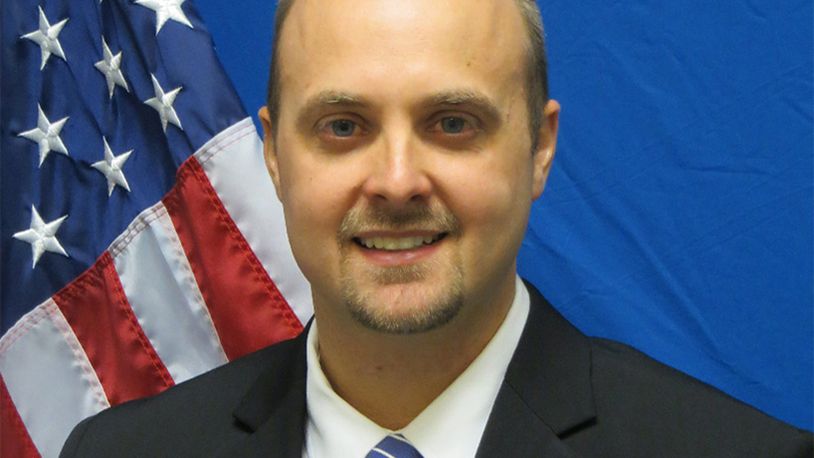
John Bailey, a 39-year-old chief engineer with the Air Force Life Cycle Management Center’s Big Safari program, was selected for the year-long Massachusetts Institute of Technology Sloan Fellows MBA program and is heading to Cambridge, Massachusetts, this summer with his wife and four children.
The origins of the fellowship program go back more than 80 years to Alfred P. Sloan, an automotive and management pioneer and former president of General Motors.
In the 1920s Sloan had a problem. High-performing, mid-level engineers at GM were not turning into good managers and leaders. Reaching out to his alma mater, the Massachusetts Institute of Technology or MIT, Sloan helped established a program for talented engineers to develop the business and leadership skills needed to become successful company executives.
Today, the highly selective fellowship draws not just engineers but successful individuals from a variety of professions and industries, from all over the world. It includes many distinguished alumni, including former United Nations secretary general and Nobel Peace Prize recipient Kofi Annan.
During his time as an engineer for Big Safari – an Air Force acquisition program for specialized special mission aircraft – Bailey has been a key member of the team. He has led large teams in providing engineering support for more a wide variety of programs. He created the systems engineering and cybersecurity strategy for a life cycle management plan for aircraft in the portfolio and he has supported various safety investigations.
“John is an exceptionally talented engineer and leader,” said Col. Jeffrey Geraghty, commander of Big Safari. “Mission success in Big Safari rests on the pillars of expertise, attitudes, authorities and relationships, and John brings tremendous capability in each of these areas. More importantly, he mentors his team toward excellence and focuses himself on personal growth to enhance mission performance. All the while, John models exemplary stature as a servant-leader at home and in his community.”
During the fellowship, Bailey’s coursework will include classes on macro and international economics, global markets, operations management, digital marketing and social media analytics, mergers, acquisitions and private equity, negotiation and strategic leadership communication.
“It is humbling to be selected for this fellowship,” said Bailey. “I’m thankful the Air Force chose to invest in me. I’m thrilled to learn new skills, and return to contribute to the acquisition community.”
“My family is also looking forward to this new adventure,” Bailey added. “My kids, ranging from ages 4 through 13, have recently turned their emotions from anxiety to excitement.”
About the Author

IMAGES
VIDEO
COMMENTS
645th Aeronautical Systems Group. Big Safari is a United States Air Force program begun in 1952 which provides management, direction, and control of the acquisition, modification, and logistics support for special purpose weapons systems derived from existing aircraft and systems. To that end, the program operates under procurement procedures ...
For further inquiries/discussion please contact: Mr. Daniel Annett - Chief of Staff Phone: (937) 255-3695 Email: [email protected]. Ms. Emily Farley - Chief Venture Officer - Innovation Phone: (937) 271-4549 Email: [email protected]. DISTRIBUTION A: APPROVED FOR PUBLIC RELEASE: DISTRIBUTION UNLIMITED 13.
This week in AFLCMC history - February 14 - 18, 2022 . In this edition of Heritage Hangar, you'll learn about old and new airplanes and tidbits of what happened this week many years ago. ... Ohio - On Friday, Aug. 10, 2018, former Big Safari Director and retired Air Force Col. Bill Grimes passed away. While his was not a household name and ...
Big Safari was eventually reactivated in 2005 after a hiatus of unknown length, though it is likely that the program was inactive from the late 1970s till the late 1980s [source]. It was in 2005 that Big Safari explicitly became the 645th Aeronautical Systems Group. The 645th is subordinated under the 303rd Aeronautical Systems Wing.
BIG SAFARI for NDIA 16 Oct 2012 Air Force Life Cycle Management Center Birthplace, Home & Future of Aerospace This briefing is: UNCLASSIFIED Mr. Brian S. Rutledge Deputy Director, 645 AESG . Birthplace, Home & Future of Aerospace In the Press "BIG SAFARI has long been an alternative
20 Apr 1962 (ISR & SOF Dir. - Big Safari) The KC-135A tail number 55-3121 entered the General Dynamics Convair facility for modification as SPEED LIGHT ECHO. This was the latest aircraft converted by Big Safari in just a few weeks to monitor nuclear weapons testing. ... 80 Years Ago This Week in AFLCMC History: 18 April 1942 (see photos above ...
Big Safari is a #USAF acquisition program that specializes in intelligence gathering, plus acquisition, modification and logistics support for special weapons systems and aircraft, and is part of the ISR & SOF directorate within AFLCMC. (U.S. Air Force photo by TSgt Matthew B. Fredericks)
Lt. Gen. Dale R. White is the Military Deputy, Office of the Assistant Secretary of the Air Force for Acquisition, Technology, and Logistics, the Pentagon, Arlington, Virginia. He is responsible for research and development, test, production, product support, and modernization of Air Force programs worth more than $60 billion annually.
AFLCMC engineer selected for MIT fellowship. WRIGHT-PATTERSON AIR FORCE BASE, Ohio - John Bailey, a 39 year-old chief engineer with the Air Force Life Cycle Management Center's Big Safari program, was selected for the prestigious year-long MIT Sloan Fellows MBA program and is heading to Cambridge, Mass., this summer with his wife and four kids.
News. On February 14, a USAF -operated Boeing TC-135W (serial 62-4133) departed Offutt Air Force Base (AFB), Nebraska, for Greenville-Majors Airport, Texas, where it will be reassigned to the air arm's Big Safari Program and redesignated as an NC-135 platform. The aircraft was flown to Texas by members of the 238th Combat Training Squadron ...
March 22, 2019. John Bailey, a 39-year-old chief engineer with the Air Force Life Cycle Management Center's Big Safari program, was selected for the year-long Massachusetts Institute of ...
Although the "Big Safari" programme office covers multiple Intelligence, Surveillance, and Reconnaissance (ISR) and Special Operations Forces (SOF) projects, Scramble Magazine can now provide an overview of its smaller, mainly white "civil coloured" aircraft. Over the past few years, Scramble has noted, through various sources, less than a handful of those rare aircraft operating in and over ...
WRIGHT-PATTERSON AIR FORCE BASE, Ohio - John Bailey, a 39 year-old chief engineer with the Air Force Life Cycle Management Center's Big Safari program, was selected for the prestigious year-long MIT Sloan Fellows MBA program and is heading to Cambridge, Mass., this summer with his wife and four kids.. The origins of the fellowship program go back more than 80 years to Alfred P. Sloan an ...
Constituted BIG SAFARI Systems Group on 23 Nov 2004. Activated on 18 Jan 2005. Redesignated 645 Aeronautical Systems Group on 14 Jul 2006. Assignments. Reconnaissance (later, 303. 645 Aeronautical Systems Group (AFMC) In accordance with Chapter 3 of AFI 84-105, commercial reproduction of this emblem is NOT permitted without the permission of ...
Engineering Team Award: Big Safari Program Office, ISR & SOF Directorate, Greenville, Texas A new award was also unveiled this year, The Jorge F. Gonzalez Engineering Analysis Award., which will be presented to the engineer who makes a substantial contribution to the AFLCMC mission through engineering analyses using tools such as those ...
AFLCMC delivers C-37B early. By Daryl Mayer, Air Force Life Cycle Management Center Public Affairs / Published March 27, 2020. PHOTO DETAILS / DOWNLOAD HI-RES 1 of 1. A new C-37B aircraft sits on the tarmac after its first night at Joint Base Andrews, Md, March 26, 2020. The special air mission aircraft was delivered to the 89th Airlift Wing by ...
Palace of Sport. Moscow, 1988. Track 2 of 10.
18 Feb 2012 (ISR & SOF Dir.—Big Safari) An Air Force Special Operations Command (AFSOC) U-28A Draco crashed, killing all four crewmembers aboard. ... (Big Safari), now part of the AFLCMC ISR & SOF Directorate. Its first project there was the modification of the Swiss-built Pilatus PC-12 small turboprop passenger/cargo plane for AFSOC use as ...
Palace of Sport, Moscow 1988. Track 1 of 10.
Palace of Sports, Moscow 1988. Track 10 of 10.
Brig. Gen. Jason D. Voorheis is the Program Executive Officer for Fighters and Advanced Aircraft, Air Force Life Cycle Management Center, Air Force Materiel Command, Wright-Patterson Air Force Base, Ohio. He is responsible for the development, production, fielding, sustainment, and modernization of the Air Force fighter portfolio, which includes the A-10, F-15, F-16, F-22, and special programs ...
#Sancharam #Siberia #SafariTV #Santhosh_George_Kulangara #Lal_JoseStay Tuned : https://www.safaritvchannel.com Enjoy & Stay Connected With Us !!---...